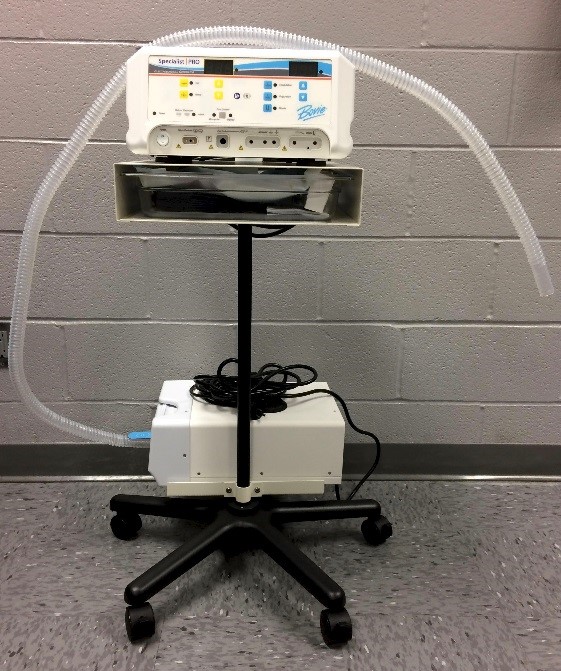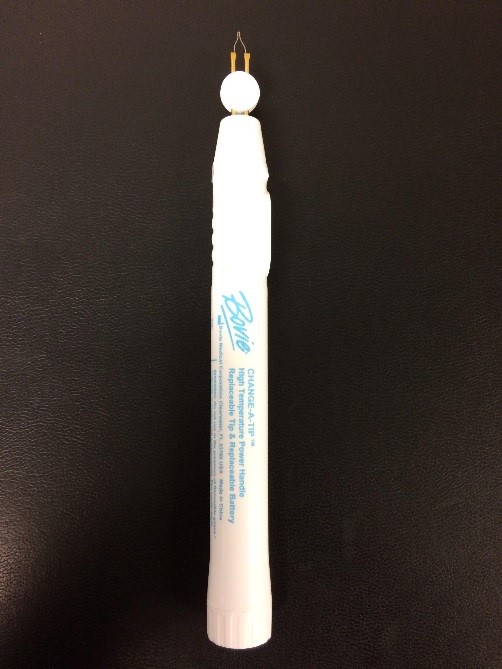
Electrosurgery Basics for Veterinary Technicians
By Dr. Jennifer Martin
Electrosurgery versus Electrocautery
Electrosurgery and electrocautery are often confused. Electrosurgery involves using a high frequency alternating electric current to either cut, fulgurate, dissect, ablate, or coagulate tissue. Electrocautery involves passing a direct or alternating current of electricity through a metal wire electrode, which heats it. The heated metal wire may be used to coagulate small blood vessels or destroy tissue. A current does not pass through the tissue or body during electrocautery as it does with electrosurgery. Electrocautery devices are small in size and typically battery operated, while electrosurgery generator units are much larger and complicated.

|

|
|
Electrosurgery Generator Unit |
Electrosurgery Device |
Patient preparation
Proper patient preparation is essential prior to an electrosurgical procedure. Since a current will be flowing from the electrosurgical generator unit through the patient, the patient must be properly grounded to avoid electrical shock. If a metal surgical table is used, it must first be covered with a rubber mat and then covered with two surgical towels. The grounding plate may then be placed on top of the surgical towels. Never place a grounding plate directly on a metal table as electric shock would occur. Next, the grounding plate must be positioned under the patient so that 85%-95% of the grounding plate is in contact with the patient. Then, a conductive gel is placed on the grounding plate to ensure good contact between the patient and the grounding plate.
Patient positioning is critical during electrosurgical procedures. Alternate site burns may be caused by the current seeking an alternate route to the return electrode. This can occur if a patient has two body parts touching, such as crossed legs or a leg touching the chest. Therefore, the patient should be placed on the surgery table in such a manner that avoids any skin-to-skin contact points. Gauze may be placed between areas of potential contact to lessen the chance of accidental contact.
It is important to note that all patient jewelry that could conduct electricity (e.g., dog collars, identification tags) should be removed prior to the electrosurgical procedure.
When preparing the surgical site, non-flammable disinfecting agents should be used. If flammable disinfectants must be used, they should be allowed to evaporate prior to using the electrosurgical generator unit.
Precautions
It is important to remember that there is a risk of fire during an electrosurgical procedure as electrical sparks could ignite flammable gasses, liquids, or other materials. As a precaution, oxygen should briefly be turned off, or the levels momentarily decreased during electrosurgical procedures near the oral cavity.
Individuals monitoring the patient should not touch the patient while the electrosurgical unit is actively being used as they would be at risk of being shocked.
Smoke Evacuation
Surgical smoke is generated during electrosurgical procedures. This smoke, which may have particles as small as 0.1 microns, is capable of penetrating through surgical masks and reaching the lungs. This smoke is hazardous to breathe and therefore must be evacuated. Smoke evacuators, which remove the plume generated by electrosurgery, consist of a vacuum pump, filter, and suction hose. The smoke evacuator should have a capture velocity of 100-150 ft/min at the inlet for the suction hose, a High Efficiency Particulate Air (HEPA) filter which filters and traps particulates in the smoke, and a suction hose which should be held 2 inches from the source of the surgical smoke during the surgical procedure. The veterinary technician should change the HEPA filter as needed according to the manufacturer’s recommendations.
Dr. Martin is the Veterinary Technology Program Director at the Colby Community College in Colby, Kansas.